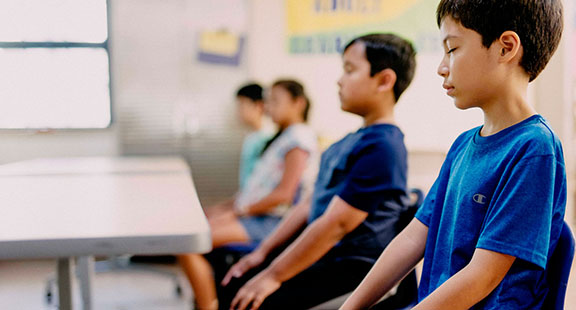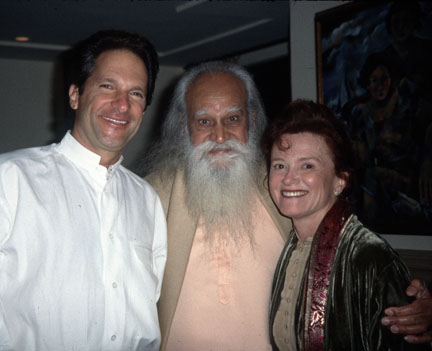 A teacher, producer, and philanthropist, Tara Guber is the founder and CEO of the nationally recognized Yoga in schools program, Yoga Ed.™ Originally motivated to try Yoga by her movie producer husband, Peter Guber (Mandalay Entertainment), Tara has now been practicing for almost four decades and for the past 24 years has shared the benefits of Yoga with children. She explains the philosophy that guides and inspires her service and generosity: “The best gift I could give to the world is the gift of Yoga.”
A teacher, producer, and philanthropist, Tara Guber is the founder and CEO of the nationally recognized Yoga in schools program, Yoga Ed.™ Originally motivated to try Yoga by her movie producer husband, Peter Guber (Mandalay Entertainment), Tara has now been practicing for almost four decades and for the past 24 years has shared the benefits of Yoga with children. She explains the philosophy that guides and inspires her service and generosity: “The best gift I could give to the world is the gift of Yoga.”
Integral Yoga Magazine: How did you begin working with children?
Tara Guber: Alan Finger was my first Yoga teacher and in the 1980s we wrote Yoga Moves. I was an elementary schoolteacher and had minored in art. This led Alan to ask me to create an after-school class at his studio for children ages 7-12. When the children first came in from school, they were bouncing off the walls. So, I had them sit on the floor, gave them paper that was folded in half and asked them to draw a picture on one side of the paper. Then we did Yoga and after Yoga, I said let’s draw on the other side. Their before Yoga pictures had dark colors, ragged edges and were filled with tension. After Yoga, the drawings had bright primary colors, happy and rainbow-like colors. I saw the impact of Yoga and how it takes us from darkness to light.
IYM: Then you became an education advocate?
TG: I wanted to bring the decay of our educational system to public awareness. So, I co-founded Education First, a program where once a year, all the studios, all the networks and agencies participate in raising awareness through public service announcements, TV programs and a one-hour after school special on CBS. It was great and raised awareness, but I after awhile I got tired of telling people that our education system was in crisis. I wanted to do something more. So, 15 years ago, I helped create the Accelerated School in South Central Los Angeles, where we raised 50 million dollars to build the school and we put Yoga Ed. into the school as a pilot program. We were part of the physical education (PE) program. Half of the students went to Yoga and half to PE. Teachers soon saw that the best time to give a test was after Yoga. They also saw that Yoga started changing how the children treated each other. When we give children time to take time out, they can take time in—time to find peace and stillness—and to give them a feeling of focus and concentration so they can show up and be present.
IYM: What is the mission of Yoga Ed.?
TG: To develop health and wellness programs and materials that utilize the psychological, emotional and educational benefits of Yoga and creative play, and to distribute them to children, teachers and parents through schools and communities nationwide. We now have hundreds of teachers trained to do Yoga Ed. We also have 15 teachers who can certify others to be Yoga Ed. trainers. The program is throughout the USA (including Puerto Rico), in Canada and soon will be in Japan and India. Corporate women are giving up careers and becoming Yoga Ed. trainers and teachers in order to have a positive impact on children in schools. The quality of people coming through in the past few years is amazing.
IYM: Would you tell us more about the program?
TG: I think Yoga Ed. should be in every school. Yoga Ed. philosophy is personal awareness. How can we teach students math, social studies and science and yet not teach them emotional intelligence—how to be nonjudgmental, to use nonviolent communication, to really listen—how to be conscious and aware? Yoga Ed. curriculums consist of time-in (includes meditation), discussions on anatomy, postures, partner poses, visualizations, relaxation and homework. In approaching schools, we share with them studies that have been conducted on how Yoga enhances performance, helps at-risk children and children with learning differences. Yoga Ed. also offers a two-day “Tools for Teachers” workshop bringing 5-15 minutes of Yoga into the classroom by teaching children visualization, meditation, postures at their desks and talking circles regarding their feelings to aid emotional healing. One tool is to teach children how to take a breath and do an affirmation before a test, “I know how to do my work. I am relaxed and am going to do the best I can do on this test. I trust myself.” Yoga is not just an exercise, but a way of life.
Fritz Perls said that boredom is a lack of attention. Once we are present, we are more interested. Once we show up in our body and have more awareness, we make better choices in our lives. We eat better, we cultivate healthier relationships to food, to our families and to ourselves. When we show up in our body, we have more awareness and make smarter choices in our diet. We teach nutrition, how to cultivate a healthy relationship to food, to our families, to ourselves, to everything.
In our high school curriculum we teach students about the inner advisor—that they can ask for help with any issue that concerns them. We teach them that breath and Yoga are one. Without breathing, there’s no Yoga.
IYM: Are you pleased with how Yoga Ed. is developing?
TG: I’m excited about where it’s going. We’re in home schooling catalogs, in PE catalogs, so PE teachers can buy the curriculum to bring into school. We’ve created decks of cards that are divided into groups—forward bends, back bends, time in, visualizations, partner poses. A child can pick a card and then the whole class joins in. Or, as the teacher, if you want to bring a feeling of oneness into the classroom, you can use a time in card. We are creating an ecology deck to teach children about such mindful practices as recycling and being globally aware.
We do a lot of partner poses based on my book, Contact Yoga, which uses seven points of contact as the foundation: trust, passion, commitment, love, communication, vision and union (which is Yoga). We teach them the seven points and what it means to trust, to make a commitment to friendship, to relationship; what forgiveness and love are about, what honest communication is about. To hold the vision for the friendship which helps create intimacy which is sorely missing in our school systems. We want to encourage clarity, centeredness and peace so our children see the world as a great place to be. All the tools of Yoga—whether it’s Hatha, Raja, Bhakti—help bring us to a place of inner harmony.
IYM: What is your view of meditation vs. medication?
TG: I think they both have their place. When you do Yoga it gives the individual the tools to make themselves feel better at any given moment. Since children with ADD have a problem with concentration and focus, Yoga is a tool to bring them into their center and it absolutely helps. It can calm them, relax them. When we stand on our heads it shifts our state. To me, if everybody in the world did something to bring themselves inside their bodies, this world would be a better place!
IYM: Why is Yoga is so effective for so many people?
TG: Yoga is an inside job. It’s not what is out there, it’s what is in here that will put us into a place of peace and wellness. Due to all the external stimuli assaulting us at every moment, we are being driven to take better care of ourselves. Yoga gives us focus and concentration, posture alignment, strength, flexibility, flow, grace and balance and helps us lead a more peaceful, less stressed life. It really gives us a better life. Meditation is not the same as running or working in the garden. It’s wonderful to do those things, but meditation is time in. Meditation is sitting still and being in a state of quiet and non-doing. It stills the mind. There is no doubt, when you run you still the mind, when you garden you still the mind. But meditation is just being and that is probably the hardest thing—to just be with ourselves and then to go beyond to just being. The expression “we are all one” is right on. Meditation takes us into the oneness. We could be in the darkest place, but if we have that tool, if we know how to open our crown chakra, like the lotus opens its petals—to open to that collective consciousness where the light shines through, that’s the way. Just as Gurudev says: “Truth is one, paths are many.”
IYM: You hosted several talks for Swami Satchidananda (Gurudev) at your Yoga House.
TG: To be in the presence of Gurudev is to be in the presence of love. He just emanates kindness and love. I always found that his inner child was always present. He really gave us permission to be that. We live in a world where we don’t have permission, we protect ourselves, we isolate and he brought us to the moment of presence. Just wonderful! Joseph Campbell said that the privilege of a lifetime is being who you are. And yet we don’t know who we are. I remember talking to Deepak Chopra about this, and he remarked, “Isn’t it strange that the essence of who we are is hard to find and yet it’s who we are!” I think the most beautiful gift in life is the gift to be yourself. Yoga is one of the most powerful tools to bring us to that possibility.
About Tara Guber:
(photo left to right: Peter Guber, Swami Satchidananda, Tara Guber)


